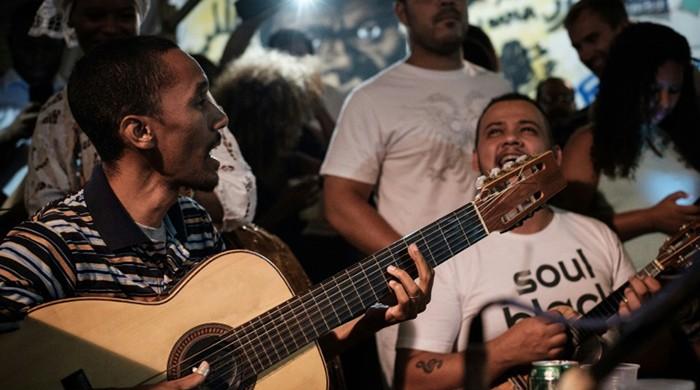
RIO DE JANEIRO: Monday nights feel like Saturdays in Rio's Little Africa neighbourhood when the sun sets and the samba-start to play.
Surrounded by a mostly young crowd, seven musicians sit around a table with the small four-string guitar called a cavaquinho, the cuica drum and a tambourine.
The instruments and the relaxed format, known as a "roda de samba," has changed little since its infancy in the late 19th century, when Afro-Brazilians first developed the style in this same neighbourhood, officially known as Saude.
"It's our samba, folks, it's your samba!" called out percussionist Walmir Pimentel, 34, to applause from the crowd that fought off the evening heat with cold beer and caipirina cocktails.
Pimentel's group has been playing Monday night "rodas" here at Pedra do Sal square since 2006, performing right at the steps where slaves once unloaded sacks of salt.
The lively performances have helped resurrect the long-depressed centre of Rio de Janeiro.
But exactly 100 years from the first ever recording of samba -- a song called "Pelo Telefone" ("On the telephone") -- the likes of Pimentel are also helping to rejuvenate the venerable art form.
The group Moca Prosa has been breaking new ground at the same symbolic space in the Little Africa neighbourhood since 2012.
As the only all-female band in a musical genre which, like much of Brazilian society, suffers from deep sexism, they let the music do their talking.
"At first, there were men in the audience who were shocked, saying, 'Wow, these girls play samba?' They looked at us with mistrust, but when the roda started, they saw we played the same," said singer Fabiola Machado, 35.
Evolution
Samba had its roots among the slaves of Brazil's northeast Bahia before arriving in Rio, then the country's capital, where it took form and became the soul of the Brazilian carnival.
Today, samba rhythms and songs are omnipresent, from the February carnivals to dance clubs, and are one of the most internationally recognisable symbols of Brazil.
But the music rooted in African traditions has not stood still.
Since that recording of "Pelo Telefone," samba has picked up layers from the Argentinian tango, the jazz-influenced Bossa Nova, samba-funk and today everything from samba-rock to samba-rap.
One of the biggest sources of regeneration for samba can be traced to another Rio neighbourhood, Lapa, which was also long run-down but re-emerged in the late 1990s as a nightlife hub.
Clubs like Carioca da Gema and Rio Scenarium were catalysts for a more professional and adventurous set of samba musicians like Moyseis Marques, Teresa Cristina, Mariene de Castro, Julio Estrela, Nilze Carvalho and second generation stars, like the children of well-known sambista Serginho Procopio.
"Our generation has this idea that everything is samba. So we have no qualms about adding a guitar or a piano," said Marques, 37. "We're seeking more harmony."
From 'telephone' to WhatsApp
The lyrics are also adapting to the new sounds and new times.
If the historic first recording sang about the then new-fangled telephone, current star Arlindo Cruz peppers his lyrics with talk of social networks and messaging service WhatsApp.
"Samba is alive, strong and creative," said historian Andre Diniz, although he added that the music was not "for the masses. Its fans have an intellectual, middle-class aspect."
At its best, samba continues to bring together old and new, just as the Rio musicians modernised what had originally been a slave tradition in the faraway north-east.
At a recent concert, the daughter of famed composer Paulinho da Viola, Beatriz Rabello, joined him on stage to present her own first album.
In the audience were some of the samba's living legends, like Monarco, the 84-year-old composer from the Portela samba school, and Nelson Sargento, 92, from the rival Mangueira School.
No comments:
Post a Comment